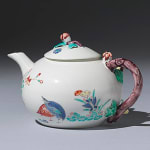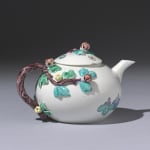

Chantilly Teapot and Cover, Circa 1735-40
Length: 5 ins (12.5 cms)
An important Chantilly Kakiemon Teapot and Cover, of compressed globular form, with faceted spout and crabstock handle issuing applied brightly coloured flowering prunus in raised relief, decorated in the Kakiemon palette with the ‘Two Quail’ pattern showing a blue quail and a red quail standing in a Chinese garden with flowering oriental plants, the slightly domed cover with flower finial.
Marks: Hunting Horn mark in red to underside of base.
The quail bird first appears in Chinese art painted on scrolls in the Song Dynasty of the 12th century. The Chinese regarded them highly and carried them around in fabric bags that hung from their waist. From time to time the owner would get it out of the bag and blow on it to arouse its fierceness. The Quail is a fierce courageous little bird,however the word quail in Chinese is pronounced ‘an’ a homophone for peace. The symbol of the two quails together is ‘shuang an’ thus double peace or a loving couple. Hence the pattern proved popular as a symbol of marriage and contentment and proceeded to travel throughout Europe and was used at Meissen before being adopted in France at Chantilly.
Provenance
Elizabeth Parke Firestone Collection and Private English Collection. Illustrated Dr. Chris Girton,‘The Two Quail Pattern, 300 years of design on porcelain’, no. 23.Join our mailing list
* denotes required fields
We will process the personal data you have supplied in accordance with our privacy policy (available on request). You can unsubscribe or change your preferences at any time by clicking the link in our emails.

